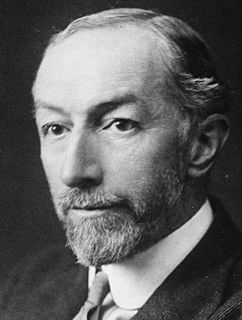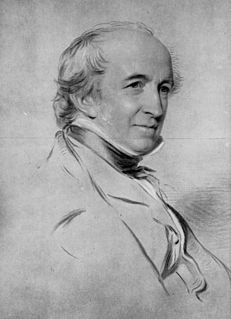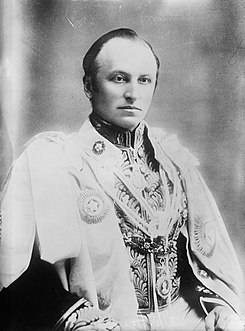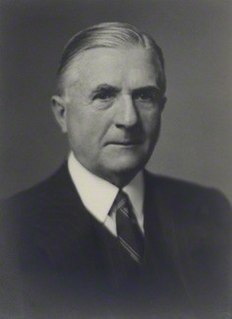
Marquess of Zetland is a title in the Peerage of the United Kingdom. It was created on 22 August 1892 for the former Lord Lieutenant of Ireland, Lawrence Dundas, 3rd Earl of Zetland. Zetland is an archaic spelling of Shetland. The Dundas family descends from the wealthy Scottish businessman and Member of Parliament, Lawrence Dundas. In 1762 he was created a Baronet, of Kerse in the County of Linlithgow, in the Baronetage of Great Britain. The title was created with remainder, failing heirs male of his own, to his brother Thomas Dundas and the heirs male of his body. He was succeeded by his son, the second Baronet. He represented Richmond and Stirling in the House of Commons and also served as Lord Lieutenant of Orkney and Shetland. In 1794 he was created Baron Dundas, of Aske in the North Riding of the County of York, in the Peerage of Great Britain. Lord Dundas notably purchased the right to the earldom of Orkney and lordship of Zetland from James Douglas, 14th Earl of Morton.

Baron Braye, of Eaton Bray in the County of Bedford, is a title in the Peerage of England. It was created in 1529 for Edmund Braye, 1st Baron Braye. However the family originally originate from Normandy, they are direct descendants of Chevalier Baudry de Bray who came over to England in the battle of Hastings of 1066. The barony was created by writ, which means that it can descend through both male and female lines. He was succeeded by his son, the second Baron. He died from wounds received at the Battle of St Quentin in 1557. Lord Braye was childless and on his death the title fell into abeyance between his sisters.

Lord Elibank, of Ettrick Forest in the County of Selkirk, is a title in the Peerage of Scotland. It was created in 1643 for Sir Patrick Murray, 1st Baronet, with remainder to his heirs male whatsoever. He had already been created a Baronet, of Elibank, in the Baronetage of Nova Scotia in 1628. His great-great-grandson, the fifth Lord, was an author and economist. He was succeeded by his younger brother, the sixth Lord, who was an admiral in the Royal Navy. On his death the titles passed to his nephew, the seventh Lord. He represented Peeblesshire in the House of Commons and also served as Lord Lieutenant of Peeblesshire.

Earl Temple of Stowe, in the County of Buckingham, is a title in the Peerage of the United Kingdom. It was created in 1822 for Richard Temple-Nugent-Brydges-Chandos-Grenville, 2nd Marquess of Buckingham, who was created Marquess of Chandos and Duke of Buckingham and Chandos at the same time. In contrast to the Marquessate and Dukedom, which were created with remainder to the heirs male of his body only, the Earldom was created with remainder to (1) the heirs male of his body, failing which to (2) the heirs male of his deceased great-grandmother the 1st Countess Temple, failing which to (3) his granddaughter Lady Anna Grenville and the heirs male of her body, and then to possible younger daughters of Lord Temple and the heirs male of their bodies.

Viscount Trenchard, of Wolfeton in the County of Dorset, is a title in the Peerage of the United Kingdom. It was created in 1936 for Marshal of the Royal Air Force, Hugh Trenchard, 1st Baron Trenchard. He had already been created a Baronet, of Wolfeton in the County of Dorset, in the Baronetage of the United Kingdom in 1919 and Baron Trenchard, of Wolfeton in the County of Dorset, in 1930, also in the Peerage of the United Kingdom. His second son, the second Viscount, held junior ministerial positions from 1979 to 1983 in the Conservative administration of Margaret Thatcher. As of 2018 the titles are held by the latter's son, the third Viscount, who succeeded in 1987. In 2004 he replaced the recently deceased Lord Vivian as one of the ninety elected hereditary peers that are allowed to remain in the House of Lords after the passing of the House of Lords Act 1999. Lord Trenchard sits on the Conservative benches.

Viscount Bridport is a title that has been created twice, once in the Peerage of Great Britain and once in the Peerage of the United Kingdom. The first creation became extinct in 1814, while the second creation is still extant.
Baron Ventry, of Ventry in the County of Kerry, is a title in the Peerage of Ireland. It was created in 1800 for Sir Thomas Mullins, 1st Baronet. He had already been created a Baronet, of Burnham in the County of Kerry, in the Baronetage of Ireland in 1797. The Mullins family claimed descent from the Norman De Moleyns family. The first Baron's grandson, the third Baron, resumed the alleged 'ancient' family name of De Moleyns by Royal licence in 1841. His son, the fourth Baron, sat in the House of Lords as an Irish Representative Peer from 1871 to 1914. Lord Ventry also assumed the additional surname of Eveleigh, which was that of an earlier ancestor. His younger son, the sixth Baron, married Evelyn Muriel Stuart Daubeny. As of 2014 the titles are held by their grandson, the eighth Baron, who succeeded his uncle in 1987. In 1966 he assumed by deed poll the surname of Daubeney de Moleyns.
Baron Newborough is a title that has been created twice in the Peerage of Ireland. Both titles are extant. The first creation came in 1716 in favour of George Cholmondeley, later 2nd Earl of Cholmondeley. See Marquess of Cholmondeley for further history of this creation. The second creation came in 1776 in favour of Sir Thomas Wynn, 3rd Baronet. He represented Caernarvonshire, St Ives and Beaumaris in the House of Commons and also served as Lord Lieutenant of Caernarvonshire. His eldest son, the second Baron, represented Caernarvonshire in Parliament. He died unmarried and was succeeded by his younger brother, the third Baron. He served as High Sheriff of Anglesey in 1847. On his death the titles passed to his grandson, the fourth Baron. He died as a result of an illness contracted on active service during the First World War and was succeeded by his younger brother, the fifth Baron. When he died in 1957 the titles were inherited by his first cousin, the sixth Baron. He was the son of the Hon. Charles Henry Wynn, third son of the third Baron. As of 2017 the titles are held by the sixth Baron's grandson, the eighth Baron, who succeeded his father in 1998.

Baron Glentoran, of Ballyalloly in the County of Down, is a title in the Peerage of the United Kingdom. It was created on 8 July 1939 for the Unionist politician Herbert Dixon. In 1950 he also succeeded his elder brother as third Baronet, of Ballymenock. His son, the second Baron, was also a politician and served as the last Speaker of the Senate of Northern Ireland. As of 2017 the titles are held by the latter's son, the third Baron, who succeeded in 1995. He is a former Olympic Bobsleigh gold medallist as well as a soldier, businessman and politician. Lord Glentoran was one of the ninety elected hereditary peers who remain in the House of Lords after the passing of the House of Lords Act 1999, and sat on the Conservative benches until his June 2018 retirement under the House of Lords Reform Act 2014.

Baron O'Hagan, of Tullahogue in the County of Tyrone, is a title in the Peerage of the United Kingdom. It was created on 14 June 1870 for Sir Thomas O'Hagan, then Lord Chancellor of Ireland. His younger son, the third Baron, served as a Lord-in-waiting from 1907 to 1910 in the Liberal administrations of Sir Henry Campbell-Bannerman and H. H. Asquith and was later a Deputy Speaker of the House of Lords. In 1909 Lord O'Hagan assumed by Royal licence the additional surname of Towneley, which was that of his maternal grandfather. As of 2010 the title is held by his grandson, the fourth Baron, who succeeded in 1961. He is the son of the Hon. Thomas Anthony Edward Towneley Strachey. Lord O'Hagan was a Member of the European Parliament for Devon from 1973 to 1975 and again from 1979 to 1994, first as an independent and later as a Conservative. He assumed in 1938 by deed poll the additional Christian name of Towneley and the surname of Strachey in lieu of his patronymic. Strachey was the surname of his maternal grandfather Edward Strachey, 1st Baron Strachie.

Baron Noel-Buxton, of Aylsham in the County of Norfolk, is a title in the Peerage of the United Kingdom. It was created on 17 June 1930 for the politician Noel Noel-Buxton, who was the second son of Sir Thomas Buxton, 3rd Baronet, of Belfield, and a great-grandson of the philanthropist Sir Thomas Fowell Buxton, 1st Baronet, of Belfield, as well as a great-nephew of Charles Buxton, the father of Sydney Buxton, 1st Earl Buxton. As of 2017 the title is held by his great-grandson, the fourth Baron, who succeeded his father in 2013. Another member of the Buxton family is Aubrey Buxton, who was created a life peer as Baron Buxton of Alsa in 1978. He is the son of Leland William Wilberforce Buxton, youngest son of the third Baronet.

Baron Silsoe, of Silsoe in the County of Bedford, is a title in the Peerage of the United Kingdom. It was created on 18 January 1963 for the barrister Sir Malcolm Trustram Eve, 1st Baronet. He had already been created a Baronet, of Silsoe in the County of Bedford, on 18 January 1943. He was succeeded by his son, the second Baron. Known as David Silsoe, he was also a barrister. As of 2017 the titles are held by his son Simon, the third Baron, who succeeded in 2005.
Baron Mostyn, of Mostyn in the County of Flint, is a title in the Peerage of the United Kingdom. It was created in 1831 for Sir Edward Lloyd, 2nd Baronet, who had earlier represented Flint Boroughs and Beaumaris in the House of Commons. His son, the second Baron, sat as a Member of Parliament for Flintshire and Lichfield and served as Lord Lieutenant of Merionethshire.

Baron Monteagle of Brandon, in the County of Kerry, is a title in the Peerage of the United Kingdom. Before he was deposed, James II had intended the title to be conferred upon one of his supporters, Stephen Rice. Instead, it was created in 1839 in the reign of Queen Victoria for the Whig politician Thomas Spring Rice, a descendant of Stephen Rice. He served as Chancellor of the Exchequer between 1835 and 1839. He was succeeded by his grandson, the second Baron, his eldest son the Hon. Stephen Edmund Spring Rice having predeceased him. The second Lord Monteagle was a unionist politician and was made a Knight of the Order of St Patrick in 1885. On his death, the title passed to his son, the third Baron. He held minor diplomatic office. He was succeeded by his uncle, the fourth Baron. He was the younger son of the aforementioned the Hon. Stephen Edmund Spring Rice, eldest son of the first Baron. As of 2017 the title is held by the fourth Baron's great-grandson, the seventh Baron, who succeeded his father in 2013.
Baron Mottistone, of Mottistone in the County of Southampton, is a title in the Peerage of the United Kingdom. It was created in 1933 for the soldier and Liberal politician J. E. B. Seely. He was the fourth son of Sir Charles Seely, 1st Baronet, and the uncle of Hugh Seely, 1st Baron Sherwood. The fourth baron, succeeded his half-brother in 1966. He notably served Lord Lieutenant of the Isle of Wight from 1986 to 1995 and as the last governor of the Isle of Wight between 1992 and 1995 and was succeeded by his son as the fifth baron, in 2011. In turn, the fifth baron was succeeded by his elder son in 2013.

Baron Tennyson, of Aldworth in the County of Sussex and of Freshwater in the Isle of Wight, is a title in the Peerage of the United Kingdom. It was created in 1884 for the poet Alfred Tennyson. His son, the second Baron, served as Governor-General of Australia, and his grandson, the third Baron, as a captain for the English cricket team. On the death in 2006 of the latter's younger son, the fifth Baron, the line of the eldest son of the first Baron failed. The title was inherited by the late Baron's second cousin once removed, the sixth and present holder of the peerage. He is the great-grandson of Hon. Lionel Tennyson, second son of the first Baron.

Baron Cottesloe, of Swanbourne and Hardwick in the County of Buckingham, is a title in the Peerage of the United Kingdom. It was created on 2 March 1874 for the Conservative politician and former Chief Secretary for Ireland, Sir Thomas Fremantle, 1st Baronet (1798–1890). He was the son of Admiral Sir Thomas Fremantle (1765–1819). Lord Cottesloe had already been created a Baronet, of Swanbourne in the County of Buckingham, on 14 August 1821, chiefly in recognition of his father's services, and with remainder to the latter's heirs. His father Sir Thomas Fremantle was created Baron Fremantle, of the Austrian Empire, which Lord Cottesloe inherited in 1819 with the death of his father. Subsequently, in 1822 he was given a Royal licence, which authorized him and his successors to use the title in Britain. However, a warrant issued on 27 April 1932 withdrew all the royal licences, only allowing the use of the title to the then current holders, their heir and their heir's heir. The fifth baron was the last holder being allowed to use the Austrian title in the United Kingdom.

Baron Ravensdale, of Ravensdale in the County of Derby, is a title in the Peerage of the United Kingdom.

There have been two baronetcies created for persons with the surname Arthur, both in the Baronetage of the United Kingdom. As of 2014 both creations are extant.

Thomas Sivewright Catto, 1st Baron Catto CBE PC was a Scottish businessman and later Governor of the Bank of England.
 Thomas Sivewright Catto, 1st Baron Catto (1879 –1959)[ citation needed ]
Thomas Sivewright Catto, 1st Baron Catto (1879 –1959)[ citation needed ] Stephen Gordon Catto, 2nd Baron Catto (1923 –2001)
Stephen Gordon Catto, 2nd Baron Catto (1923 –2001) Innes Gordon Catto, 3rd Baron Catto (b. 1950)
Innes Gordon Catto, 3rd Baron Catto (b. 1950)

















